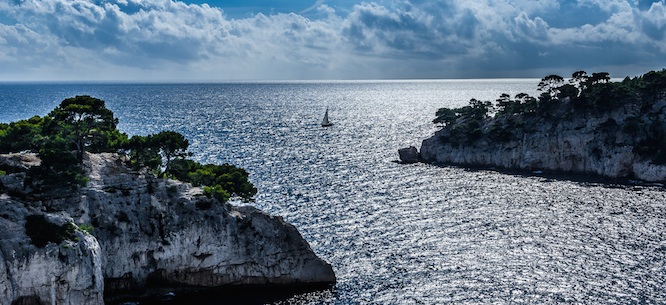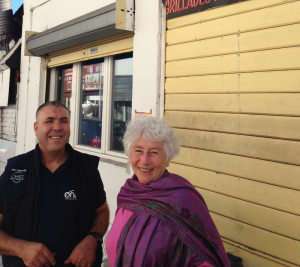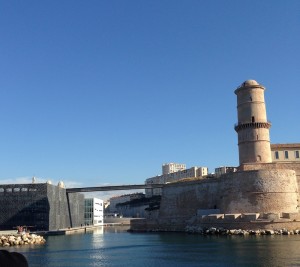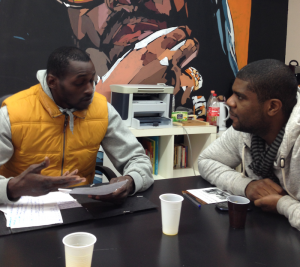Letter from Marseille
Letter from Marseille
As “urban renewal” threatens to further marginalize the city’s poor, Marseille activists are demonstrating that genuine cultural, environmental, and social renewal can go hand in hand.

After one of the warmest Marseille autumns in recent memory, the famous Mistral has finally whistled into town from the cold European steppes. Pointillist swirls of leaves and paper wrappings have taken the place of bathers at la Plage des Catalans and other local bathing spots. It’s just as well for me; chilly weather makes it easier to catch some of the city’s busy thinkers and doers inside the cafes long enough to get their take on this ancient yet ever-changing seaport.
Signs everywhere claim Marseille as a “city of culture.” Culture, meaning all the arts and performances, is indeed one of the ways Marseille is trying to redefine itself in opposition to persistent stereotypes of crime and conflict. By featuring the talents of its enormously polyglot population, the city’s leaders hope to demonstrate that its people do indeed sing and dance and create art together across all the social divides. It is a hope sometimes realized, in ways that are made conspicuous for tourists and other casual observers. It is also a hope challenged by the realities of urban development and the rise of the anti-immigrant right.
Like so many projects of “urban renewal,” Marseille’s cultural triumph risks casting aside those whose neighborhoods are most in need of renewing. Meanwhile, their neighborhoods continue to face pollution, isolation, and neglect. But a dedicated group of Marseille activists hopes that cultural, environmental, and social renewal can go hand in hand. As a fellow at the city’s Méditerranéenne Institute of Advanced Studies, I’ve had the fortune of spending time over the past five months with some of these inspiring activists. Over the course of many conversations about their projects, and about the city’s issues of social justice, they’ve convinced me that despite its many economic and social problems, Marseille is reinventing itself in ways that demand our renewed attention.
In 2012, when my wife Didi and I spent two weeks here, construction barriers were everywhere. Preparing to star as European Capital of Culture for 2013, the city was in the throes of a building boom that extended from the outer edge of the old port along almost a mile of the Joliette district of industrial and passenger docks and surrounding warehouse on the city’s northwestern shoreline. Two years later, the impressive architectural results of all the digging and concrete pouring are there to be enjoyed, especially by the streams of tourists or affluent Marseille residents who gather at the new, extremely upscale shopping center overlooking the Cruise ship docks.
The centerpiece of the $7 billion European and French Euroméditerranée (EuroMed) urban renewal project is the MuCEM, or Museum of European and Mediterranean Civilizations, a boxy exhibition and cultural center surrounded by an outdoor plaza at the water’s edge that was until recently an industrial no man’s land. (Film fans may remember this location from the climactic final scene of John Frankenheimer’s 1975 French Connection II.) The MuCEM’s exhibition spaces and its expositions are still finding their cultural identity, but the fourth-floor roof garden, overlooking the old port and the blue sea beyond, is an outstanding success reminiscent of Manhattan’s High Line. This is an opinion largely shared by the Marseillais I speak with, even though most feel that the benefits of all this glitzy new construction won’t be shared by the city’s poor and working class populations.
The pathways through MuCEM’s rooftop gardens eventually converge at a long bridge that descends into Le Panier, one of the city’s original port neighborhoods. The Panier’s steep and narrow streets and its eighteenth- and nineteenth-century residences have seen a great deal of renovation and tender preservation. In the way of most ancient neighborhoods that survive into this century, the Panier is fast becoming a center of chic boutiques, though it remains home to a diminishing population of immigrant and working-class residents. The cultural production evident in the new stores and galleries is impressive, if somewhat predictable. But all over the city, there are conferences, performance spaces, and theatrical events that attest to the richness of the cultural movements in this seaport of so many outdated stereotypes.
Questions about Marseille’s relationship to its spectacular natural landscape motivate a second transformative turn. New Yorkers and others living near low-lying coastlines are reasonably anxious about sea level rise. In Marseille, where the shoreline is elevated, a prospective rise in sea level does not threaten serious flooding. The ecological issues here are about how to create parks and protected landscapes, how to address the toxicities left by generations of industrial pollution connected with the history of port expansion, and how to ensure that people living in the older industrial zones will benefit from new investments in ecological restoration.
On the city’s more affluent southeastern flanks, the coastline is crenellated with cliffs, corniches, coves, and creeks, and the celebrated calanques, all of which either tower above or funnel down to the shockingly blue Mediterranean. The calanques of Marseille are coastal canyons of varying size, often with soaring pinnacles and sheer cliffs that plunge straight into the sea. They can best be explored by boat, but most are accessible by car and by public buses that serve their small fishing and yacht harbors. The city’s green activists and many other informed and engaged citizens are rightfully proud of their newly created Parc National des Calanques, the first such national park within a French metropolitan region. But they are also upset that pollution from the residues of nearby factories continues to pour through outfalls within the park. As elsewhere in the urban world, the battles are never entirely over when a park is created.
On Marseille’s far needier north side, environmental and social issues are joined for the poor and working-class people in much that same ways that environmental justice activists have highlighted in places like the Bronx, the south side of Chicago, and Richmond, California. I came to Marseille to study life along a polluted stream that crosses the entire north side of the city and drains through an underground culvert into the port. The fate of this urban stream, the Ruisseau des Aygalades, tracks Marseille’s history of port expansion, industrial growth and decline, and the more recent isolation of its working class neighborhoods. New efforts at restoring the stream, and the neighborhoods around it, introduce this curious visitor to just about every major ecological issue confronting the city’s troubled northern region—which have parallels far beyond the city limits.
My mentor in all things Aygalades is Christine Breton. A longtime Marseille resident and activist and an accomplished author, Christine recently retired from one of the city’s cultural agencies, where she seems to have become admired by all the Marseillais I meet, especially those who are involved in local organizing. She is particularly admired as one of the founders of a unique urban cooperative, Hotel du Nord, Marseille.
Christine invited me to lunch recently at an outdoor grill run by an affable Algerian friend, Samir, at the huge flea market in the port neighborhood known as les Crottes. Over steaming bowls of stewed vegetables and couscous, she talked about the Hotel du Nord project and its relationship to the public housing neighborhoods that border on the Ruisseau des Aygalades.
Christine explained that the Hotel du Nord cooperative enlists active residents of the massive apartment blocks known here and elsewhere in France (especially when they house poor people) as cités. On Marseille’s north side, scores of cités stand on the hills overlooking the container port and cruise ship docks. These apartment buildings cluster among active and abandoned factories perched on these same hillsides. This mixed industrial and residential land use dominates the landscape, a tortured habitat that extends to l’Estaque, the last port community within Marseille proper, made famous over a century ago by Cezanne and his friends. Today these neighborhoods are reputed to be dangerously violent centers of the city’s drug trade. They are, it’s almost needless to say, disproportionately populated by the city’s minority residents—North African, black, and Roma (gypsy). As always, the negative stereotypes are built on grains of truth, but they generalize to become self-fulfilling prophesies that local organizers like Christine Breton seek to correct.
People associated with the Hotel du Nord Cooperative who live in the cités and nearby neighborhoods offer rooms in their homes to visitors who want to experience a different side of Marseille life. Because many of the apartments are public housing owned by the state, the residents cannot be paid for rentals. Christine smiles with some satisfaction as she explains that, to avoid breaking the rules, the hosts in social housing are paid by the cooperative for taking visitors on informative local walks. Christiane Martinez, a delightful neighborhood activist whom I met at La Visitation, a cité along the ruisseau, introduced me to her neighbors and has taken me and other guests for walks along the hilly streets of her neighborhood. She and the other activists point out environmental issues created by local factories. But they also point to positive efforts of some local companies to bring art and social action projects into their properties, often due to the organizing efforts of the Hotel du Nord cooperative.
Many of these walks border the Ruisseau des Aygalades. But the stream itself can be hard to make out. At La Visitation I could only catch glimpses of it from the heights of an overgrown green slag heap or through the gates of factory parking lots. “The workers who park in these lots,” Christiane Martinez said, “they come in from neighborhoods far from here. Nobody has much work around here.” Youth unemployment in many of the cités stands at over 40 percent—Martinez puts it at more than fifty.
One of the largest factories along the stream is the Saint Louis sugar refinery, whose most important client in the region is Coca Cola. In contrast, the housing projects this sugar refinery borders on are producing the makings of social dynamite. Throughout France’s cités there is a growing sense of frustration and disappointment with the current socialist government for failing to improve the chances of young, out-of-work adults. (Youth unemployment across France stands at about 24 percent—roughly twice the U.S. rate.) In Marseille, to make matters worse, local socialist leaders have been implicated in damaging corruption issues.
Back at the flea market, after a second glass of Samir’s hot mint tea, Christine takes me on a walk along the lower reaches of the Ruisseau des Aygalades, nearer to the port, in the surrounding neighborhoods of Les Crottes and la Cabucelle. Again the stream is only momentarily visible, here beneath a roadway, or over there flowing deep within a concrete embankment. “Bill, tu arrives à Marseille à un très bon moment,“ Christine tells me. I’ve come to the city at an opportune time, she claims, because phase two of the EuroMed private public partnership has announced plans to restore the Ruisseau des Aygalades for the public’s and nature’s benefit, but there are lots of doubts about who will gain and who will lose in the process.
To bring the stream to the surface as a flowing body of water, the planners engaged by EuroMed propose expanding a small local park through which it runs and creating a streambed able to accommodate flooding from occasional mountain torrents. The plans are ambitious and the sketches by Parisian planners and architects quite attractive. But this lower stretch of the Ruisseau des Aygalades passes through les Crottes and La Cabucelle, two very old neighborhoods of Marseille’s maritime working class. While they are charmingly authentic, especially to an urban socio-archeo-anthropo-ecological sentimentalist like me, one has to admit that both neighborhoods are in shabby condition. But the unrestored nineteenth- and early twentieth-century residential buildings are full of Marseille working-class family life spilling into the old streets on skateboards and scooters and motorcycles.
Undoubtedly the new plans will involve “urban renewal” of these visually and socially remarkable neighborhoods. Les Crottes and La Cabucelle don’t reflect well on Marseille the ambitious cultural capital, the city-of-this-century pushing inexorably along the waterfront by the efforts of busy EuroMed construction crews and their giant overhead cranes. I gather from Christine Breton, however, that while there may not be much public outcry about the likely gentrification of les Crottes and La Cabucelle, there is a related and far more widespread fear throughout the northern housing blocks. Architectural sketches of a shiny “restored” Les Crottes flea market, which also houses one of Marseille’s largest mosques, strike fear that the market is destined for a “renewal” that will price out and drive away people like stocky, warmhearted Samir, whose couscous is so delicious and so reasonably priced.
As I continue to meet more of the city’s engaged and active citizens, I hear Christine Breton celebrated as a Marseille version of New York’s (and Toronto’s) Jane Jacobs. Christine is more understated; her writing about the city’s northern neighborhoods links environmental and social issues in ways that Jacobs did not. Nor is Christine likely to become the public voice against the top-down impositions of the EuroMed projects. Her approach, through the Hotel du Nord cooperative, is quieter but hardly lacking in passion. She and her allies invest much of their effort in educating the public about local issues of environmental justice. They find creative ways, like the walking tours, to reach out to the socially isolated residents of the public housing neighborhoods in an effort to enlist local leadership there. Their challenge is great and they approach their work with impressive dedication and proper humility.
The Marseille one reads about in New York has a different and less sunny aspect. The anti-immigrant Marseille, the ethnically tense Marseille, the criminal and violent Marseille, the anti-Semitic Marseille are all present here as well. I have not sought them out but this is after all a major port of the Mediterranean, and like any great seaport it has its darker sides. Recently there has been a rise in support for the Front National, even among some of the residents of the housing projects I have been visiting on the city’s north side. In the municipal elections of 2014 a Le Pen candidate, Stéphane Ravier, took over control of the local municipal government in the city’s traditionally left-voting thirteenth and fourteenth arrondissements. Marseille itself has had a conservative mayor for over twenty years, but the northern arrondissements were traditionally a stronghold of the socialists and communists. Ravier’s victory further discourages the city’s embattled socialist militants, who saw the proportion of their vote continue to decline. In Marseille, support for the anti-immigrant and nativist positions of the Front National have always been stronger in the suburbs and smaller towns surrounding the far more diverse central city. But Ravier and other Le Pen candidates for municipal office are increasingly able to win votes in the cités by fostering a politics of resentment of religious Muslims, Roma, and more recent immigrant neighbors, especially the African Muslims from the islands of Comoros. In this regard the political cleavages in Marseille and its surrounding region bear much similarity to the politics of Tea Party strongholds in Arizona and Texas.
Even in the chilly weather, the Marseille skies remain sunny and blue. The streets are full of running, laughing children. Many of the adults I coax out of the brilliant light and into the cafes are also working on projects that concern the city’s northern neighborhoods. Like Christine Breton they seek a merging of cultural and environmental movements. A young Marseille author and publisher, for example, Baptiste Lanaspeze, runs a successful company called Wildproject Editions. He has published translations of American environmental pioneers like Aldo Leopold as well as two of his own volumes about local ecological issues. His company’s most recent publications by local authors, one a former boxer from the cité known as La Castallane, are about life in the northern neighborhoods, viewed in ways that challenge the usual stereotypes. Over the course of 2013, he and Christine Breton worked together on an extraordinary series of nature walks within and outside the city that covered over 250 kilometers of the region and explored every conceivable urban and natural habitat the region has to offer.
Like Christine Breton and Baptiste Lanaspeze, Samia Chabani of the organizing group known as Ancrages (“anchorages”) centers her efforts on the city’s northern districts. One of her projects seeks to preserve the archives from the immigration prison at l’Arenc. Now a renovated EuroMed commercial site along the port, this is where North African and other workers without proper documentation were for many years, and until quite recently, interned and secretly deported.
The Marseille activists I am meeting are just as upset about recent political setbacks as are Americans with similar progressive aspirations. They have a lot to be proud of, however. Notwithstanding the city’s ethnic and religious tensions and the difficult economic challenge posed by high unemployment in its poorest communities, this remains, by American standards, a socially democratic city. Its residents enjoy an almost utopian health system, an array of enviable child care institutions, and a transportation network that allows me to go anywhere in minutes. There are troubling trends here that threaten prospects for environmental and cultural innovation. But my list of innovative projects and Marseille activists continues to expand. It’s as if the subterranean Ruisseau des Aygalades keeps the city awake and humming with creativity and action.
William Kornblum is a professor of sociology at the City University of New York and a member of Dissent’s editorial board. He is currently a resident research fellow at the Mediterranean Institute for Advanced Studies, University Aix-Marseille, Marseille, France.







